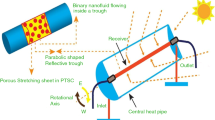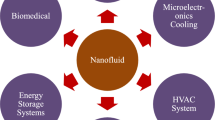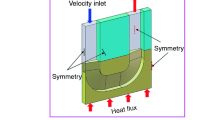Abstract
To overcome the environmental problems during manufacturing process, the twin-fluid atomization has been demonstrated as an efficient technique to reduce the lubri-cooling fluid consumption and its pollution emission. However, the coupling between the gas, liquid, and structure of the twin-fluid nozzle directly affect the droplet characteristics and size distribution, which has a significant effect on the processing performance. In the current work, the droplet characteristics during the collaborative atomization process of a twin-fluid nozzle with two kinds of atomizing cores are investigated and compared via a phase Doppler particle analyzer (PDPA), and the droplet diameter and size distribution of a new twin-fluid nozzle (NTN) with different atomizing cores are further investigated. The results reveal that the spray atomization characteristics and droplet size distribution are obviously influenced by the performance of primary and secondary atomization, which mainly depend on the atomizing core structure and the gas to liquid mass flow rate ratio (GLR). Because the gas acceleration performance of the new atomizing core is better than that of the standard atomizing core at the same GLR, compared with the standard twin-fluid nozzle (STN), the droplet diameter decreases by approximately 33.97%, the droplet number concentration and axial velocity increase by approximately 36.39% and 34.51%, respectively, and the spray cone angle of the STN is only approximately 80% of that of the NTN. Meanwhile, the higher GLR of the twin-fluid nozzle provides more energy for the droplets, so the viscous force between the liquids is easier to overcome and the atomization characteristics are improved. Nevertheless, for a smaller GLR, the droplet size distribution is significantly affected by the structural parameters of the NTN atomizing core due to the insufficient atomization power. Moreover, a smaller throat diameter, a smaller exit diameter, and a moderate distance between the liquid channel and the atomizing core exit are beneficial for improving the droplet cumulative distribution.













Similar content being viewed by others
References
Zhang X, Li C, Jia D, Gao T, Zhang Y, Yang M, Li R, Han Z, Ji H (2019) Spraying parameter optimization and microtopography evaluation in nanofluid minimum quantity lubrication grinding. Int J Adv Manuf Technol 103(5–8):2523–2539
Su Y, Lu Q, Yu T, Liu Z, Zhang C (2019) Machining and environmental effects of electrostatic atomization lubrication in milling operation. Int J Adv Manuf Technol 104(5–8):2773–2782
Mao C, Zhou X, Yin L, Zhang M, Tang K, Zhang J (2016) Investigation of the flow field for a double-outlet nozzle during minimum quantity lubrication grinding. Int J Adv Manuf Technol 85(1–4):291–298
Xu X, Lv T, Luan Z, Zhao Y, Wang M, Hu X (2019) Capillary penetration mechanism and oil mist concentration of Al2O3 nanoparticle fluids in electrostatic minimum quantity lubrication (EMQL) milling. Int J Adv Manuf Technol 104(5–8):1937–1951
Poozesh S, Grib S, Renfro M, Marsac P (2018) Near-field dynamics of high-speed spray dryer coannular two fluid nozzle: effects of operational conditions and formulations. Powder Technol 333:439–448
Danh V, Jiang L, Akinyemi O (2019) Investigation of water spray characteristics in the near field of a novel swirl burst injector. Exp Thermal Fluid Sci 102:376–386
Zaremba M, Weiß L, Malý M, Wensing M, Jedelský J, Jícha M (2017) Low-pressure twin-fluid atomization: effect of mixing process on spray formation. Int J Multiphas Flow 89:277–289
Luo H, Nishida K, Uchitomi S, Ogata Y, Zhang W, Fujikawa T (2018) Microscopic behavior of spray droplets under flat-wall impinging condition. Fuel 219:467–476
Wang Z, Wen J, Wang J, Dong Q (2014) PDPA investigation on an electrostatically-assisted twin-fluid atomization flow. Adv Mech Eng 6:402747
Luo H, Nishida K, Ogata Y (2019) Evaporation characteristics of fuel adhesion on the wall after spray impingement under different conditions through RIM measurement system. Fuel 258:116163
Fan X, Wang J, Zhao F, Li J, Yang T (2018) Eulerian–Lagrangian method for liquid jet atomization in supersonic crossflow using statistical injection model. Adv Mech Eng 10(2):13
Kim K, Choi Y (2018) Numerical simulation on the generation of ultrasound and formation of water fog in the ultrasonic gas atomizer. Ultrasonics 11:002
Baillot F, Blaisot J, Boisdron G, Dumouchel C (2009) Behaviour of an air-assisted jet submitted to a transverse high-frequency acoustic field. J Fluid Mech 640:305–342
Narayanan S (2013) Atomization in the acoustic field of a Hartmann whistle. Int J Spray Combust 5(1):1–24
Narayanan S, Srinivasan K, Sundararajan T (2013) Acoustic characteristics of external chamfered Hartmann whistles. Appl Acoust 74(9):1104–1116
Ruan C, Xing F, Huang Y, Yu X, Zhang J, Yao Y (2017) The influence of acoustic field induced by HRT on oscillation behavior of a single droplet. Energies 10(1):48
Ficuciello A, Blaisot J, Richard C, Baillot F (2017) Investigation of air-assisted sprays submitted to high frequency transverse acoustic fields: droplet clustering. Phys Fluids 29(6):319–321
Gelfand B (1996) Droplet breakup phenomena in flows with velocity lag. Prog Energ Combust 22(3):201–265
Theofanous T (2011) Aerobreakup of Newtonian and viscoelastic liquids. Annu Rev Fluid Mech 43:661–690
Yang C, Chen B, Jiang W, Gao D, Jin G (2016) Analysis and experiment on atomizing characteristics of supersonic nozzle based on Laval effect. Trans Chinese Soc Agric Eng 32(19):57–64
Mates S, Settles G (2005) A study of liquid metal atomization using close-coupled nozzles, part 1: gas dynamic behavior. Atom Sprays 15(1):19–40
Mates S, Settles G (2005) A study of liquid metal atomization using close-coupled nozzles, part 2: atomization behavior. Atom Sprays 15(1):41–60
Chen B, Gao D, Liang Y, Zhao J, Sun Y (2018) Experimental investigation of atomization and droplet turbulence characteristics of a twin-fluid nozzle with different self-excited vibrating cavity structures. Exp Thermal Fluid Sci 99:525–536
Chen B, Gao DR, Yang C (2017) Atomizing characteristics of twin-fluid impact nozzle based on PDPA. Trans Chinese Soc Agric Mach 48(4):362–369
Bian J, Cao X, Yang W, Guo D, Xiang C (2020) Prediction of supersonic condensation process of methane gas considering real gas effects. Appl Therm Eng 164:114508
Canosa A, Ocana A, Antinolo M, Ballesteros B, Jiménez E, Albaladejo J (2016) Design and testing of temperature tunable de Laval nozzles for applications in gas-phase reaction kinetics. Exp Fluids 57(9):152
Chen B, Gao D, Wu S, Zhao J (2018) Influence of self-excited vibrating cavity structure on droplet diameter characteristics of twin-fluid nozzle. Chin J Mech Eng 31(1):73
Hou D, Jiang W, Zhao W, Bian J, Liu Y, Lai X (2018) Effect of linetype of convergent section on supersonic condensation characteristics of CH4-CO2 mixture gas in Laval nozzle. Chem Eng Process 133:128–136
Ochowiak M (2013) The experimental study on the viscosity effect on the discharge coefficient for effervescent atomizers. Exp Thermal Fluid Sci 50:187–192
Kourmatzis A, Lowe A, Masri A (2017) Conditioned analysis of effervescent atomization. J Energ Eng 143(5):04017019
Xia Y, Khezzar L, Alshehhi M, Hardalupas Y (2018) Atomization of impinging opposed water jets interacting with an air jet. Exp Thermal Fluid Sci 93:11–22
Mlkvik M, Stahle P, Schuchmann H, Gaukel V, Jedelsky J, Jicha M (2015) Twin-fluid atomization of viscous liquids: the effect of atomizer construction on breakup process, spray stability and droplet size. Int J Multiphas Flow 77:19–31
Madero J, Axelbaum R (2017) Spray breakup and structure of spray flames for low-volatility wet fuels. Combust Flame 180:102–109
Santolaya J, Garcia J, Calvo E, Cerecedo L (2013) Effects of droplet collision phenomena on the development of pressure swirl sprays. Int J Multiphas Flow 56:160–171
Jia W, Li P, Qiu B, Shi A (2008) Application of phase Doppler particle analyzer in reek spray nozzle's characteristic experiment. China Rural Water and Hydrop 2008(9):70–72
Wittner M, Karbstein H, Gaukel V (2018) Pneumatic atomization: beam-steering correction in laser diffraction measurements of spray droplet size distributions. Appl Sci-Basel 8(10):1738
Cai Y, Liu Z, Shi Z (2017) Effects of dimensional size and surface roughness on service performance for a micro Laval nozzle. J Micromech Microeng 27(5):055001
Cai Y, Liu Z, Shi Z, Song Q, Wan Y (2015) Residual surface topology modeling and simulation analysis for micro-machined nozzle. Int J Precis Eng Man 16(1):157–162
Zeng X, Qiu W, Ji S, Xi F, Qiu L, Zheng Q, Meng S (2019) Optimization and experimental research on process parameters of the softness consolidation abrasive particles. Int J Adv Manuf Technol 104(1–4):1017–1026
Zeng X, Li J, Ji S, Pan Y, Hang W (2017) Research on machining characteristic of double-layer elastomer in pneumatic wheel method. Int J Adv Manuf Technol 92(1–4):1329–1338
Zeng X, Li Z, Xi F, Ji S, Qiu L, Shi M, Zheng Q, Qiu W (2019) Material removal characteristic of laser cladding cobalt-based alloy in the photochemical process. Metals 9(6):1–13
Qiu L, Ji S, Zeng X, Jin M, Li Z, Ge M (2019) Research on partition segment grinding path method of aero-engine blade based on robot group. IEEE SENS J. https://doi.org/10.1109/JSEN.2019.2949250
Piao Z, Xu B, Wang H, Yu X (2019) Rolling contact fatigue behavior of thermal-sprayed coating: a review. Crit Rev Solid State Mat Sci. https://doi.org/10.1080/10408436.2019.1671798
Piao Z, Zhou Z, Xu J, Wang H (2019) Use of X-ray computed tomography to investigate rolling contact cracks in plasma sprayed Fe–Cr–B–Si coating. Tribol Lett 67(1):11
Ba K, Yu B, Gao Z, Zhu Q, Ma G, Kong X (2019) An improved force-based impedance control method for the HDU of legged robots. ISA T 84:187–205
Pavlov V, Tunik Y (2012) Detonation combustion of hydrogen in a Laval nozzle under rarefied atmosphere conditions. Fluid Dynam 47(5):647–653
Matz M, Aumiller M (2014) Practical comparison of cylindrical nozzle and de Laval nozzle for wire arc spraying. J Therm Spray Techn 23(8):1470–1477
Ba K, Yu B, Zhu Q, Gao Z, Ma G, Jin Z, Kong X (2019) The position-based impedance control combined with compliance-eliminated and feedforward compensation for HDU of legged robot. J Frankl Inst Eng Appl Math 356(16):9232–9253
Funding
This work was supported by the Natural Science Foundation of Zhejiang Province (grant number LR18E050003), the National Natural Science Foundation of China (grant numbers 51905481 and 51975523), the Open Foundation of the State Key Laboratory of Fluid Power and Mechatronic Systems (grant number GZKF-201820), the Natural Science Foundation of Hebei Province (grant number E2017203129), and Postdoctoral Preferred Funding Project of Zhejiang Province (grant number zj2019019).
Author information
Authors and Affiliations
Corresponding author
Additional information
Publisher’s note
Springer Nature remains neutral with regard to jurisdictional claims in published maps and institutional affiliations.
Rights and permissions
About this article
Cite this article
Chen, B., Gao, D., Li, Y. et al. Investigation of the droplet characteristics and size distribution during the collaborative atomization process of a twin-fluid nozzle. Int J Adv Manuf Technol 107, 1625–1639 (2020). https://doi.org/10.1007/s00170-020-05131-1
Received:
Accepted:
Published:
Issue Date:
DOI: https://doi.org/10.1007/s00170-020-05131-1




